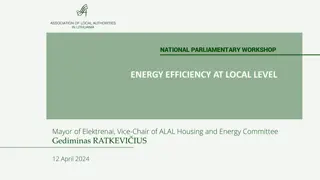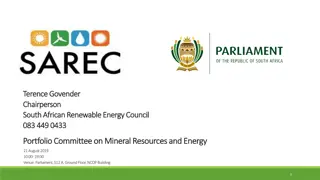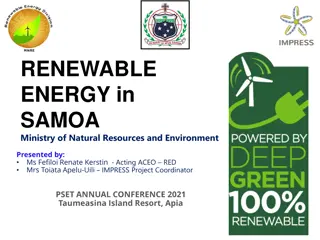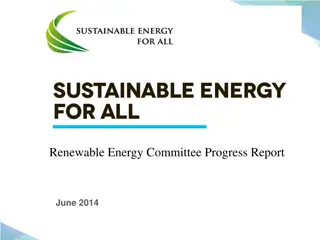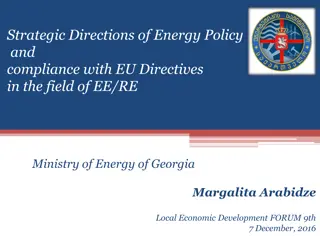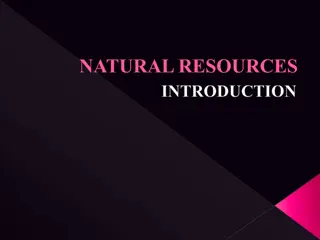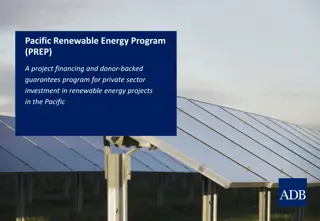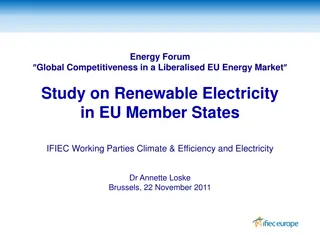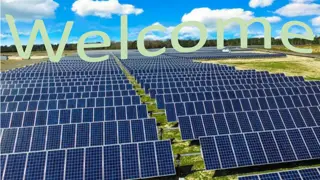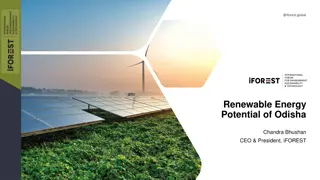Overview of Energy Resources: Renewable and Non-Renewable
Energy resources are classified into renewable and non-renewable types, with a mix of both used worldwide. Non-renewable resources dominate global energy consumption, with fossil fuels like oil, natural gas, coal, and nuclear energy being major sources. While non-renewable sources still dominate, efforts are being made to transition towards renewable energy options like hydro, solar, and wind power to create a sustainable energy future.
Download Presentation

Please find below an Image/Link to download the presentation.
The content on the website is provided AS IS for your information and personal use only. It may not be sold, licensed, or shared on other websites without obtaining consent from the author.If you encounter any issues during the download, it is possible that the publisher has removed the file from their server.
You are allowed to download the files provided on this website for personal or commercial use, subject to the condition that they are used lawfully. All files are the property of their respective owners.
The content on the website is provided AS IS for your information and personal use only. It may not be sold, licensed, or shared on other websites without obtaining consent from the author.
E N D
Presentation Transcript
Types of energy resources 0 Renewable and non-renewable 0Energy mix combination of renewable and non-renewable resources
Types of energy resources examples of non-renewable 0 Oil 0Natural gas 0Coal 0Nuclear energy
Domination of Non-renewable resources 0Fossil fuels are by far the largest energy source human use: these make up 85% of the worlds energy use; 0 34-37% as Oil 0 25% as Coal 0 20-23% as Natural Gas 0 6% Uranium (Nuclear Energy) also a non- renewable.
Oil 0 Contributes 27.7% (Asia Pacific) 0 Main source of energy in North, South & Central America, Europe & Eurasia, Middle East & Africa. 0 Middle east accounts 51%
Coal 0 Fossilized plants mined by open cast mining or long tunnels. Burnt to provide heat, or to create electricity by turning turbines in power stations 0 Advantages: Plentiful supply (should last another 250 years more). Easy to transport as a solid. No processing required. Relatively cheap to mine and convert to energy. 0 Disadvantages: Cannot be replaced once used (non-renewable). Burning releases carbon dioxide which is a greenhouse gas. 0 contain 10% sulphur which can form sulphur dioxide and acid rain. 0 Particles of soot from burning coal can cause SMOG (pollution in cities) and lung disease. Coal mines lead to degraded (damage) land and pollution. 0 Lower heat of combustion than other fossil fuels (less energy released per mass)
NATURAL GAS 0Methane gas and other hydrocarbons trapped in the rock. Extracted by drilling. Often found with crude oil. Used directly in homes for heating and cooking. 0Advantages: Highest heat of consumption. Lots of energy gained from it. Ready made fuel, no processing required. Relatively cheap form of energy. Cleaner than coal or oil. 0Disadvantages: Only a limited supply of gas with an estimated 70 years remaining. Also gives of carbon dioxide but only half of the produced by coal
Nuclear Energy 0 Forms smallest contribution in Asia, Pacific, Africa and South & Central America. 0 Important in Europe, Eurasia and North America.
Renewable energy 0 Hydro electricity 0Wind energy 0Bio-fuels 0Solar power 0Geothermal energy 0Tidal energy 0Fuel Wood 0 15% comes from renewable energy sources
Renewable Energy Hydroelectricity 0 Big four HEP nations 0 China, Canada, Brazil and USA 0 Forms 50% of the global consumption 0HEP locations large scale development 0Small scale HEP plants in developing countries to supply local communities
HYDROELECTRIC POWER 0 Energy harnessed from the movement water through rivers, lakes and dams to power turbines to generate electricity. 0 High-quality energy output compared to low-quality energy output. Creates water reserves as well as energy supplies. Reservoirs can also be used for recreation. Safety record is good. 0 Costly to build. Can cause the flooding of surrounding communities and landscapes. Dams have a major impact on local Hydrology. Downstream lack of water. Risk of flooding if dam bursts
WIND 0Wind turbines turn wind energy into electricity. Usually found as many together in wind farms`. 0Clean supply of energy once turbines are made. Little maintenance required. 0Need the wind to blow. Often windy sites are not near populated areas. Manufacture of wind farms can be costly. Noise pollution. Some local people complain that it spoils the countryside. Maybe some birds are killed by turbines.
WIND 0World wide capacity of wind energy 200 000 MW 0Global wind report 2010 estimates reports doubling in 3-4 yrs. 0Dominated only in small no. of countries 0China 22.7% of global capacity 0Repowering play important role for longevity 0New developments
SOLAR 0Conversion of solar radiation into electrical energy via chemical energy. 0Potentially infinite energy supply. Single dwellings can have their own electricity supply. Safe to use. Low quality energy converted to high. 0Manufacture and implementation of solar panels can be costly. Need sunshine, do not work in the dark.
Geothermal Energy 0 Natural heat found in the Earth s crust in the form of steam, hot water and hot rock. 0 Heat due to GEOTHERMAL GRADIENT : rate at which temperature rises as depth below the surface increases. 0Avg. rise in temperature ~300C per km, the gradient can reach ~800C near plate boundaries
Tidal Power 0 Acts like underwater wind mills, transforming sea currents into electrical current. 0 More predictable than solar or wind. 0Infrastructure is less obstructive, but start up costs are high. 0240 MV rance facility in North-West France 0 Ex: Canada s Bay or Fundy in Nova Scotia
Fuel Wood 0 ~ 2.5 billion people rely on Fuel wood, Charcoal and animal dung for cooking. 0Fuel wood and charcoal are collectively called fuel wood. 0 Fuel wood used much in Sub-Saharan Africa, Asia.
Factors affecting Non renewable resources - OIL 0 Rapidly rising Oil cost fluctuation 0Concentrated in Middle East, political instability for import 0Reserves: Production ratio different in countries having reserves. 0Natural disasters hurricanes in US, Gulf of Mexico 0Peak oil production (2013-2037) followed by 3% fall every year. 0Geopolitics, Strategic petroleum reserves (SPR) 0Revolts
Factors affecting choice of energy resources 0 Choice of energy changed over time due to: a) Technological developments to use other forms of energy b) Increasing national wealth c) Changes in demand d) Changes in price fluctuation & instability e) Environmental factors/public opinion f) Physical, Economic, technical, political and cultural reasons





